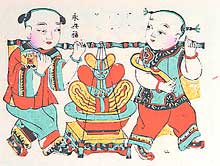The Yanhuang Art Museum is ringing in 2008 with a collection of New Year's paintings to be displayed until the end of Spring Festival. The exhibits, which include depictions of deities, auspicious figures, fairytales, farm work and opera scenes, showcase the rich variety and imaginative presentations of the ancient art genre.
The predominant characters in these works are chubby children, whose fair complexions, rosy cheeks and smiling eyes, create a mood of merriment throughout the show.
Clad in traditional attire, these kids hold gold ingots, ride fish, eat fruit and play in groups. The backgrounds are always blank or feature simple patterns, bringing the action of children into focus.
But it's not all kids' stuff. Scenes of everyday life and rural existence are a big part of the exhibition. Several works depict with harmonious composition wedding ceremonies, harvest celebrations, bustling streets and festival celebrations.
Many of the other super-realistic subject matters are included because of their cultural implications. Images of God are associated with protection and happiness, while cranes, pines and peonies symbolize health and longevity, and goldfish and gold ingot are believed to bring wealth.
The palette is one of brightness and strong contrast, with the most prevalent colors being vermillion, blue, green, sienna, pink and purple. The painting technique is delineated by ink brush lines and is distinguished by its own folksy character, which is a mainstay of farm culture.
The New Year painting genre has a long history, recorded as early as the Song Dynasty (AD 960-1279). The three famous bases for the genre are Weifang's Yangjiabu, of Shandong Province, Yangliuqing, of Tianjin, and Taohuawu, of Suzhou, in Jiangsu Province.
Traditionally, farmers used New Year's paintings to decorate their homes during festivals, especially the lunar New Year.
Usually pasted on doors, windows and walls, the New Year's paintings come in pairs. To create balance and symmetry, the two pictures should be of similar composition with minor differences in the details.
Having originated from real life, the art form is without the restrictions of time and space. The images are somewhat exaggerated, and the spectacles are condensed versions of ordinary scenes.
Venue: Yanhuang Art Museum, 9 Huizhong Lu, Asian Games Village, Chaoyang District
Opening hours: 9am-4pm
Tel: 010-6491-4394/0909
(Beijing Weekend by Wu Liping January 4, 2008)


